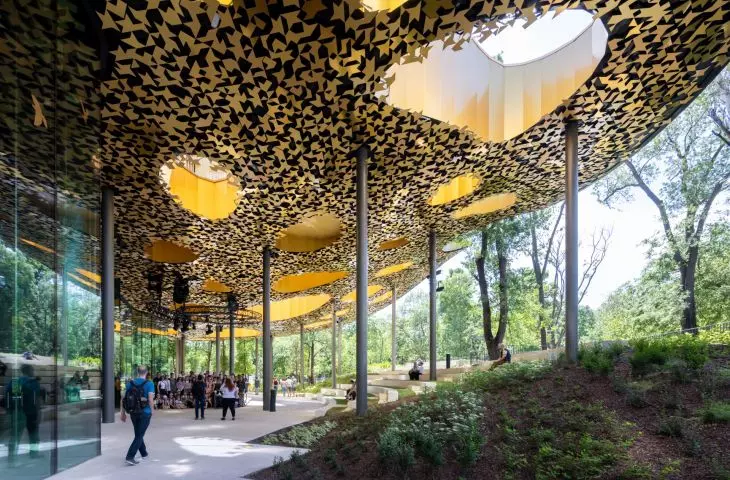House of Hungarian Music,
designed by Sou Fujimoto Architects
Thanks to the House of Hungarian Music, which has been built in Budapest, one can experience not only an aesthetic but also a sonic experience in the capital's 200-year-old city park. The architectural project by Japanese studio Sou Fujimoto Architects is part of Liget Budapest, the largest cultural revitalization in Europe, which includes the construction and modernization of cultural institutions in the green areas of the park.
architecture inspired by a forest of sounds
The 9,000-square-meter Hungarian Music House is distinguished by an organic form that contrasts with the historic buildings scattered in and around the park, while harmoniously interacting with nature. The almost entirely glass façade and the trees planted inside the building allow constant contact with nature, even after crossing the threshold, while the open spaces of the first floor seamlessly connect the interior with the surroundings.
Hungarian Music House in Budapest - the open spaces of the first floor seamlessly connect the interior with the surroundings
©Iwan Baan
The building's canopy consists of more than 30,000 leaf-shaped decorative elements suspended from the ceiling and stabilized by a steel structure composed of thousands of honeycomb-like modules.
The organic form of the House of Hungarian Music in Budapest contrasts with the historic buildings scattered around the park and its surroundings
©Iwan Baan
A roof inspired by sound waves
The building's white roof alludes to the diversity of sound waves - the vast, undulating surface changes its depth while remaining below the tree line of the city park. Its structure features nearly 100 oval-shaped openings that allow the treetops to penetrate the building and let in light, resembling a walk under a natural canopy of leaves.
The House of Hungarian Music in Budapest - first floor view
©Iwan Baan
Making music is at the heart of the human experience. The House of Music is a unique institution that aims to showcase the beauty of sound and music and the important role it plays in every aspect of our lives
- says András Batta, director of the House of Music and former president of the Liszt Academy of Music.
House of Hungarian Music in Budapest - first floor plan
©Sou Fujimoto Architects
exhibition and educational spaces
The building is divided into three levels that reflect the three parts of a musical score. On the underground level there is space for permanent and temporary exhibitions. The first floor includes two concert halls: a smaller hall with glass walls, used mainly for lectures and workshops, as well as a concert venue and auditorium, and an open-air stage located at the entrance to the building, which hosts concerts both during the day and in the evening. The top floor houses educational spaces, a library and a terrace.
House of Hungarian Music in Budapest - a cross-section of the building
©Sou Fujimoto Architects
innovative sound solutions
The acoustic design was carried out by Nagata Acoustics, a Japanese company. Nagata's collaboration with architect Fujimoto overcame the challenges of the building's glass design. They created a zigzag-shaped wall that allows sound to reflect and disperse from the glazed surface, leading to a homogeneous sound.
Hungarian Music House in Budapest - the zigzag-shaped wall allows sound to be reflected and dispersed from the glazed surface, leading to a homogeneous sound
©Iwan Baan
eco-friendly solutions
The Hungarian Music House is equipped with an innovative heating and cooling system, based mainly on geothermal energy and other renewable sources to meet the building's energy needs.
musical journeys in space and time
The institution presents Hungary's rich musical traditions and its significant role in the history of European music to both domestic and international visitors through interactive exhibitions - both permanent and temporary - using 21st century technology, educational workshops, and outdoor music events and concerts. The permanent exhibition will provide visitors with a journey through two thousand years of music making in Europe - from the musical achievements of prehistoric man, through key moments in music history, to a wide range of avant-garde and popular music driven by the technological revolution of the 20th and 21st centuries.
The House of Hungarian Music in Budapest is divided into three levels
©Iwan Baan
The House of Music in Budapest combines landscape with architecture, offering visitors a new perspective on music making and its impact on our lives. This innovative concept has received international recognition, as evidenced by awards from the International Real Estate Awards, which recognized it as the best building. In addition, the Music House was named Best Use of Music in Real Estate Development by Music Cities, highlighting its role in shaping cultural and musical spaces.
Elaborated: Anastazja Dżupina
Illustrations provided courtesy of Sou Fujimoto Architects.















































